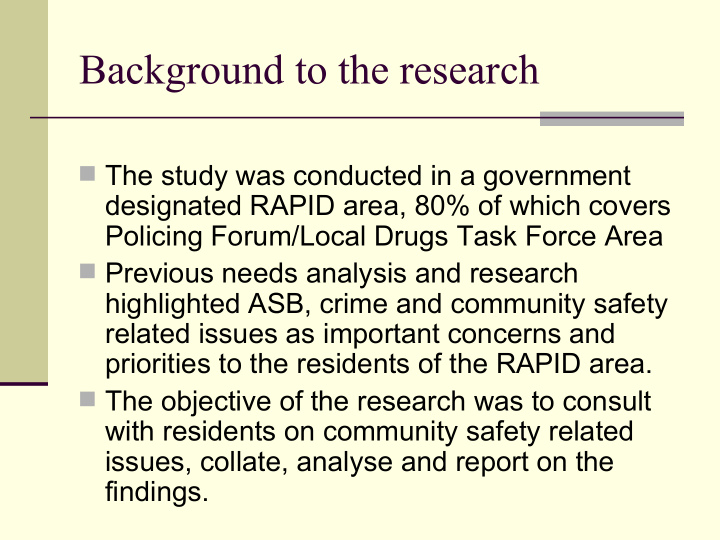



Background to the research The study was conducted in a government designated RAPID area, 80% of which covers Policing Forum/Local Drugs Task Force Area Previous needs analysis and research highlighted ASB, crime and community safety related issues as important concerns and priorities to the residents of the RAPID area. The objective of the research was to consult with residents on community safety related issues, collate, analyse and report on the findings.
Where is RAPID, Blanchardstown?
RAPID- Deprivation Index According to the widely used Haase Deprivation Index, the RAPID area measured below the average level of affluence using CSO 2006 figure. Further, according to this index, certain areas within RAPID are disadvantaged Or very disadvantaged
The People Involved The Research Steering Group: Statutory Agencies; FCC & Gardaí, Local Development & Community Organisations; BLDTF, CDP, BYS Safer Blanchardstown Representative Research Authors/Analysts; Consultant, DCU student, BLDTF & FCC The survey was conducted by community researchers who received training.
Survey Design The survey consisted of 29 questions. Questions were agreed on through the Research Steering Group. Questions asked about physical appearance of estate, Safety, Crime & ASB (anti-social behaviour), Community Relationships Considered Tralee RAPID Community Safety Survey (2008), Community Safety Initiative, Consultation Report, Tallaght West (2008), Garda Public Attitudes Survey and Dept Justice, Fear of Crime In Ireland (2009)
Sampling Frame Aim was to connect with 10% of RAPID households for the face-to-face survey. Every 10 th house was included. Of the 2,715 households in the local authority estate areas in the RAPID area, 297 householders completed an interview. Focus groups meetings were held in three community centres in the three study area
Focus Groups Three focus group meetings. Attendants were drawn form the community. Sessions facilitated by consultant and student researcher Topics of discussion were, among others, safety concerns, criminality, ASB and responsibility. Themes were drawn from the focus group discussions and included in the quantitative analysis along with the survey results.
Pilot Phase The survey was piloted to ensure suitability Interviews were conducted as part of the pilot and issues that arose were used to refine the survey questionnaire and process in general. Responses were confidential: No householder was identified as giving a particular response. Feedback sessions with the community researchers discussed any issues they faced on the doorsteps
The aims of the research were…. To identify commonalities and differences To provide information that will inform partners how resources might be deployed/prioritised more effectively To provide evidence based research that will inform policy and strategies in relation to policing/anti social behaviour/drugs & alcohol and other community safety matters To consider way in which community safety might be enhanced and improved
Witnessed Crimes This shows that in each category, more than half of respondents had witnessed instances of crime and/or anti social activity . The highest percentage of respondents identified drinking in public, Joyriding/speeding
Victims of Crime Almost a quarter of respondents recorded they were either a victim of vandalism OR harassment/intimidation.
Issues Found This shows that almost 87% of respondents had an issue with litter, damaged fencing, railings or boundary walls also figured highly
Map: Perceived Incidents & Unsafe Areas A correlation was found between open areas and people feeling unsafe
Findings (1) What makes a safe community? Less crime/ASB, no fear, sense of community, more policing, people taking responsibility, feeling involved and listened to What would make estate safer? More police presence, mechanisms to slow cars, increased parental responsibility, community spirit, neighbourhood watch, reduced drug use/drug dealing/alcohol and more facilities for teenagers
Findings (2) Confidence gap in authorities ability to deal satisfactorily with issues – linked to confidentiality, perceived threat. Large differences around feelings of safety across 3 study areas and between different estate areas Respondents in study area were more likely to have been a victim of crime in some categories than state average Parks and open spaces very vulnerable
Findings (3) Good community relations were seen as important. Majority felt they had good relations with their neighbours. However, when asked about people looking out for each other and a sense of community, Mulhuddart came out the with the lowest score. Neighbourliness is one thing, but it was felt that the community didn’t come together in times of significant perceived threat. Issues should be tackled in a shared fashion with the community along with agencies.
Quotes & Comments (1) ‘‘People who are given houses in the community should be given a charter contract of loyalty and responsibility to their neighbours and to the community in which they live’ ‘We should go back to the Neighbourhood Watch scheme which worked for years’ ‘There is a need to collaborate with each other in addressing the problems which exist within our estates. We need to be working together more closely’ ‘People involved in serious criminal and antisocial activity should be evicted from the estate regardless of the fact that they are renting or buying their houses, the Gardaí and the Council know who they are’
Quotes & Comments (2) ‘There is a lack of faith in the authorities and a fear of repercussions’ ‘People are very worried about the levels of violence and anti-social activity which are taking place both day and night’ ‘Gangs of youths should not be allowed to gather on corners in order to get as drunk as they can’ ‘A lot of off licences sell alcohol to underage people and also deliver to underage people in their own homes’
Recommendations Recommendations were agreed collaboratively through Research Steering Group. These come under FOUR headings- Prioritisation Communication Community Responsibility Enforcement
The Future To discuss individually and collectively how recommendations/initiatives will be carried forward. To work immediately on principles of prioritisation and community involvement/responsibility Baselines established, revisit survey in 2012/13 consider inclusion of young people & local business in separate/same.
Recommend
More recommend